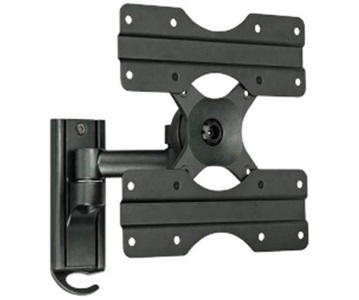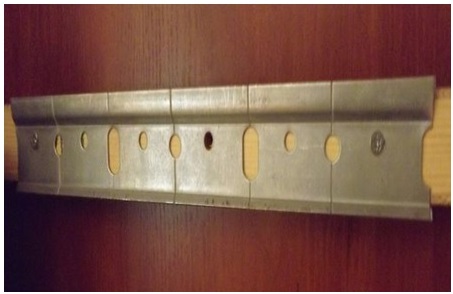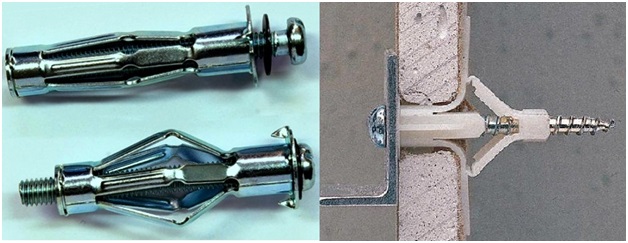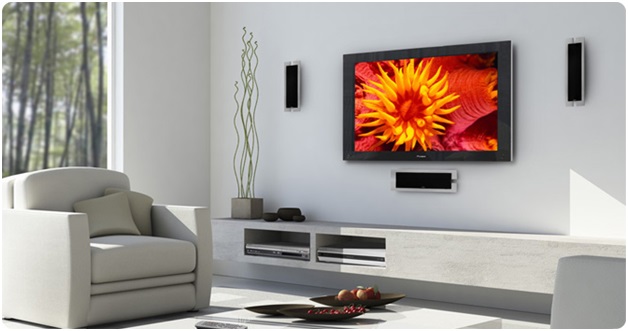Previously, TVs could only stand. After the advent of flat screens, it became possible not only to install them, but also to hang them. How to hang a TV on the wall? What mounting methods are used when mounting a TV?
Ways to fix the TV to the wall
The choice of support and method of its attachment is determined by the size of the monitor, the characteristics of the wall, as well as the weight of the device. The weight of a medium-sized TV screen varies from 15 to 35 kg. A large monitor weighs more. A large-screen plasma TV (greater than 60 inches) or an LCD TV up to 65 inches can be mounted on any wall (concrete, brick, or drywall) using amplifiers if the screen is heavy. You can also hang a curved TV on the wall, its thickness is only 5 mm.
Knowing how to mount a flat screen will help you decide how to properly hang your TV. Let's list them:
- support mount - a device that fixes the screen on a vertical metal strip with a gap of several centimeters. The support can be factory-made or home-grown, made from improvised means;
- a bracket is a hand-held device to which a television screen is attached. Various models of brackets differ in the degree of mobility, angles of rotation. According to these features, the brackets are classified into rigid, inclined and tilt-rotary.
How to choose a bracket
The rules for mounting video equipment indicate that a gap is required between the back of the screen and the wall surface. Therefore, it is better to hang the TV on the wall using a support or bracket. Without a gap, you can mount, as already mentioned, only small screens.
Also keep in mind that it is preferable to hang small screens on brackets with a movable “arm”. If the screen has a large diagonal, then for safety it is better to mount it on a fixed version of the bracket. The model is also selected according to the weight and diagonal of the TV.
To hang the TV on the wall on the bracket without fear of falling, you need to choose the right model of the mounting device, its characteristics and installation method. Modern industry produces brackets of two types: with rigid fixation and adjustable (they can change the position of the screen, tilt or rotate its plane). In addition, the characteristics of the bracket indicate the maximum diagonal of the monitor (or its weight), which can be hung on this fixture. As well as the VESA mount standard, which stipulates certain distances between mounting holes.
Types of brackets:
- rigid fixation of the "arm" of the bracket - ensures a constant position of the screen. Tilt mount - provides screen tilt up to 20º, as well as a distance from the support - 15 cm;
- tilt-swivel fasteners are the most functional and expensive bracket. It is delivered ready-made, requires responsible assembly.
Choosing a mounting method
How to hang a TV on a wall with a bracket
We take out the bracket and sort the parts. The kit consists of two parts: a wall panel and the bracket itself (attached to the screen). We collect the necessary details. These parts are attached separately: the plate is attached to the wall, and the bracket is attached to the back of the TV screen.

Photo 1. Wall bracket
Make sure there are no wires before drilling holes in the wall. Then mark their location strictly perpendicular to the TV. After drilling, insert the bolts to securely fasten the wall panel.
Now the bracket is attached to the screen with the bolts from the kit. And now the whole structure is going - the bracket is attached to the panel on the wall.
How to hang a TV on the wall without a bracket
Instead of a bracket, you can use another device - a flat support. Its use is necessary to provide the necessary ventilation gap between the back of the screen and the supporting surface. It is convenient to hang on a support when the screen size is small.
The support for a flat TV can be assembled from improvised means, which allows you to save some part of the family budget. A metal furniture “tire” is used as a base, anchor plates for windows are used for fastening. The “tire” is attached to a wooden bar with self-tapping screws (they are screwed into holes that were prepared in advance with a drill). After the bar is mounted to the wall along with the tire.

Photo 2. Furniture tire
In order to strengthen the screen on the furniture rail, anchor window plates are used. They are attached to the back of the flat screen with screws. If the anchor plates are too long, they are shortened (cut with scissors for metal or a grinder). When the plates are fixed, the screen is put on a furniture rail (they are hooked to the anchor plate).
We figured out that there are two ways to mount the monitor and TV screen to a vertical support - using a rigid support and a bracket. And now let's look at how to attach supports and brackets to various walls (concrete, wood, plaster or clay) and hang the TV on a plasterboard wall.
If the mounting points are poorly visible on the TV panel, and the bolt heads are filled with easily damaged plastic, and they are designed for a special key and a regular screwdriver will not work for them, only a specialist should mount this TV. At the end of the work, he puts his seal on the warranty card. Otherwise, all warranties will be void.
Wall material and choice of fasteners
We list the types of walls and the features of the fasteners that are used for each material:
- concrete and brick - use dowels for concrete and brick with a length of 50 mm or more;
- for wooden surfaces - use fixing dowels with a length of 30 mm or more;
- for drywall surfaces - special dowels are used in the shape of a butterfly, snail. When screwed in, they open from the inside and form an extension-lock. These dowels are called "hollow wall attachments". They are suitable for all types of framed hollow structures (plasterboard, plywood or OSB).

Photo 3. Butterfly dowel before and after screwing
The installation method depends on the wall material. To hang the LCD TV on the wall for a more secure and durable mounting, use the wall plug. Thanks to such screwing, the screw (self-tapping screw) will hold the structure more securely than when fastened directly to the wall.
Hanging a TV on a solid brick is an easier task than mounting a screen to a frame wall. The hollow structure may not support the weight of a large screen (it can reach 30 kg). Is it possible to hang a flat TV weighing 10-20 kg on drywall without additional reinforcement? Let's analyze this mounting option in more detail.
How to hang a TV on a plasterboard wall: general rules
The most durable and reliable installation of the monitor on drywall provides for the reinforcement of the GKL sheets or the fastening of the support to the internal metal profile. This allows you to solve the question of how to hang the TV on a plasterboard wall.
With additional reinforcement of drywall with plywood, it is installed behind the GKL sheets. In this case, a sheet with a thickness of at least 10 mm is used. This greatly enhances the bearing capacity of the wall, making it possible to mount a heavy screen weighing more than 35 kg to it. When mounting on drywall, butterfly dowels are used so long that they pass through a layer of drywall and plywood.

If you want to get the most reliable installation in this case - to a metal profile, then it will be easier to perform it during the wall assembly process. If the frame structure has already been mounted, you can determine the location of the profile with a metal detector and drill holes for dowels at the location of the profile.
With a relatively small weight of the TV screen (up to 30 kg), installation can be carried out without additional reinforcement of the support.
How to hang a TV on a plasterboard wall: technology
Builders allow hanging objects weighing up to 35 kg on drywall. Therefore, a lightweight monitor can be hung on the GKL, the weight of which does not exceed the indicated values. So, to understand how to hang a TV on the wall with your own hands, you need:
- Assemble that part of the bracket (or support) that will be attached to the wall.
- Drill holes in the wall, attach the support panel to them and screw in the butterfly dowels.
- Assemble the second part of the support - hooks, and fix them on the back of the TV.
- Hang the TV using hangers.
Video on how to hang a TV on the wall
The video demonstrates the process of attaching something to a drywall wall, showing ways to strengthen the wall. Thus, it will be able to withstand a certain weight.
To answer the question of how to properly hang a TV on the wall, professional knowledge is not needed. If you are in doubt about the choice of mounting method, use the strongest option that guarantees the maximum reliability of your installation.
In contact with

